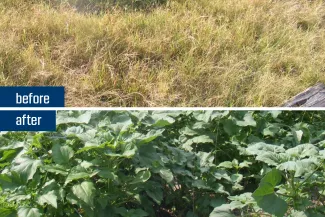Wildlife-minded landowners readily look for ways to enhance their properties and James Flinchbaugh of Grant County is no different. He had plenty of bermudagrass but few pheasants and quail. Knowing that bermudagrass and wildlife aren’t a good match, he reached out to the Wildlife Department for advice.
Flinchbaugh’s dedication to habitat is already paying off – just one year after beginning work, pheasants and quail are far more common. And nongame species have benefitted as well. So how did the habitat script flip? With prescribed fire and targeted chemical treatments.
Since first consulting the Wildlife Department, Flinchbaugh has completed two prescribed burns and several chemical sprayings. The burns were used to prep the area for chemical treatment as thick dead or dormant bermudagrass can keep the chemical from being effective. Next, the green bermudagrass foliage was sprayed while it was actively growing. Six inches of growth is usually the goal for chemical treatment. If there is plenty of moisture, bermudagrass will continue to develop through the growing season, offering the opportunity to spot spray problem areas into the fall. The worst times to spray bermudagrass are when the plant is brown and dormant, and when drought conditions persist and the grass is inactive.

The seedbank plays a large role in what brood habitat springs up after the bermudagrass is controlled. For Flinchbaugh, it was an incredible stand of annual sunflowers. Other properties may see ragweed, marestail, croton, pigweeds, lambsquarters, or a host of other early successional plants. Brood habitat is simply a canopy of forbs providing cover overhead and open space and bare ground underneath for birds and their broods to easily maneuver and feed. The dense bermudagrass Flinchbaugh started with prevented much game bird use, but the newly created brood cover is making his property more inviting to all game birds.
Today, the bermudagrass is largely absent, though the invasive plant is rarely ever fully eliminated. Flinchbaugh will likely be treating pockets of bermudagrass for years. Additionally, brood habitat requires planning and management as long-lived forbs, grasses, and woody species will eventually begin to take hold.
Evaluating the condition of your property’s current habitat types will help determine what may be missing or in short supply. If brood habitat is limited, it may be best to continue to manage the site for early successional vegetation through periodic disturbance, such as light disking, grazing, prescribed burning, spraying or a combination of all. If nesting habitat is lacking, the site can be planted to a native warm-season mix or depending on the seedbank and other variables, the site can be allowed to naturally transition to perennial native vegetation over time. Visiting with your local private lands biologist is a great way to get started.